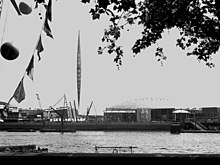
The Millennium Dome was the original name of the large dome-shaped building on the Greenwich Peninsula in South East London, England, which housed a major exhibition celebrating the beginning of the third millennium. As of 2022, it is the ninth largest building in the world by usable volume. The exhibition was open to the public from 1 January to 31 December 2000. The project and exhibition were highly contentious and attracted barely half of the 12 million customers its sponsors forecasted, and so were deemed a failure by the press. All the original exhibition elements were sold or dismantled.
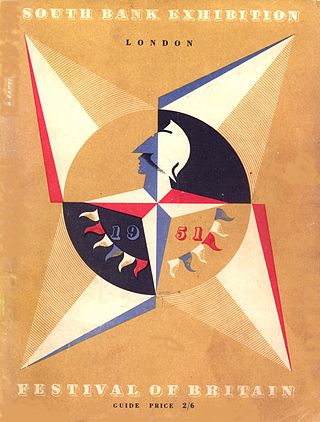
The Festival of Britain was a national exhibition and fair that reached millions of visitors throughout the United Kingdom in the summer of 1951.

The Trylon and Perisphere were two monumental modernistic structures designed by architects Wallace Harrison and J. Andre Fouilhoux that were together known as the Theme Center of the 1939 New York World's Fair. The Perisphere was a tremendous sphere, 180 feet (55 m) in diameter, connected to the 610-foot (190 m) spire-shaped Trylon by what was at the time the world's longest escalator. The Perisphere housed a diorama by Henry Dreyfuss called Democracity which, in keeping with the fair's theme "The World of Tomorrow", depicted a utopian city-of-the-future. The interior display was viewed from above on a moving sidewalk, while a multi-image slide presentation was projected on the dome of the sphere. After exiting the Perisphere, visitors descended to ground level on the third element of the Theme Center, the Helicline, a 950-foot-long (290 m) spiral ramp that partially encircled the Perisphere.
The year 1951 in architecture involved some significant events.
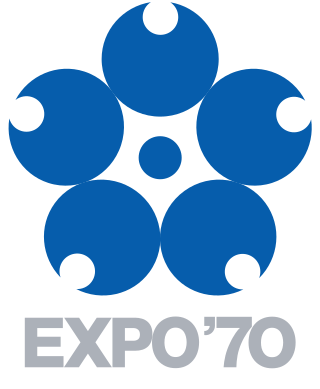
The Japan World Exposition, Osaka, 1970 or Expo 70 was a world's fair held in Suita, Osaka Prefecture, Japan between March 15 and September 13, 1970. Its theme was "Progress and Harmony for Mankind." In Japanese, Expo '70 is often referred to as Ōsaka Banpaku (大阪万博). It was the first world's fair held in Japan and in Asia.

The Franco-British Exhibition was a large public fair held in London between 14 May and 31 October 1908. It was the first in the series of the White City Exhibitions. The exhibition attracted 8 million visitors and celebrated the Entente Cordiale signed in 1904 by the United Kingdom and France. The chief architect of the buildings was John Belcher.

Ralph Tubbs OBE FRIBA was a British architect. Well known amongst the buildings he designed was the Dome of Discovery at the successful Festival of Britain on the South Bank in London in 1951.
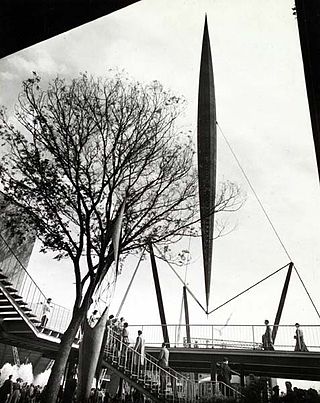
The Skylon was a futuristic-looking, slender, vertical, cigar-shaped steel tensegrity structure located by the Thames in London, that gave the illusion of floating above the ground, built in 1951 for the Festival of Britain.

Jubilee Gardens is a public park on the South Bank in the London Borough of Lambeth. Created in 1977 to mark the Silver Jubilee of Elizabeth II, the site was formerly used for the Dome of Discovery and the adjacent Skylon during the Festival of Britain in 1951. A multimillion-pound redevelopment of the park was completed in May 2012, just before the Diamond Jubilee of Elizabeth II and the 2012 Summer Olympics, in order to transform it from a state of grassland to a mature looking park with trees and hills. The re-developed Gardens were designed by Dutch landscape architects West 8. Queen Elizabeth II reopened the gardens in October 2012.
Events from the year 1951 in art.

Queen's Gate House, still commonly known by its previous name of Baden-Powell House, is a conference centre in South Kensington, London. It was built as a tribute to Lord Baden-Powell, the founder of Scouting, and has served as the headquarters for The Scout Association, as a hostel providing modern and affordable lodging for Scouts, Guides, their families and the general public staying in London and as a conference and event venue.
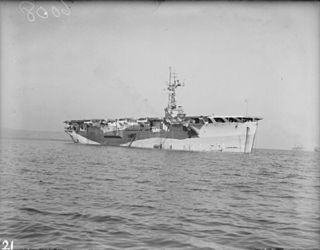
HMS Campania was an escort aircraft carrier of the Royal Navy that saw service during the Second World War. After the war, the ship was used as a floating exhibition hall for the 1951 Festival of Britain and as the command ship for the 1952 Operation Hurricane, the test of the prototype British atomic bomb.

The O2 is a large entertainment district on the Greenwich peninsula in South East London, England, including an indoor arena, a music club, a Cineworld cinema, an exhibition space, piazzas, bars, and restaurants. It was built largely within the former Millennium Dome, a large dome-shaped canopy built to house an exhibition celebrating the turn of the third millennium; consequently The Dome remains a name in common usage for the venue. It is sometimes referred to as The O2 Arena, but that name properly refers to the indoor arena within The O2. Naming rights to the district were purchased by the mobile telephone provider O2 from its developers, Anschutz Entertainment Group (AEG), during the development of the district. AEG owns the long-term lease on the O2 Arena and surrounding leisure space.
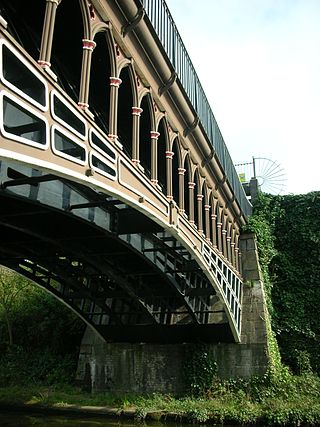
The Horseley Ironworks was a major ironworks in the Tipton area in the county of Staffordshire, now the West Midlands, England.

The Design Research Unit (DRU) was one of the first generation of British design consultancies combining expertise in architecture, graphics and industrial design. It was founded by the managing director of Stuart Advertising Agency, Marcus Brumwell with Misha Black and Milner Gray in 1943. It became well known for its work in relation to the Festival of Britain in 1951 and its influential corporate identity project for British Rail in 1965. In 2004, DRU merged with Scott Brownrigg architects.
Painter Brothers is a major British fabricator of structural steelwork and one of the leading producers of bolted lattice steelwork in the world.
George Cohen, Sons and Company was a scrap metal merchant with offices in Commercial Road, London. The company was founded by George Henry Cohen (d.1890) as Messrs. George Cohen & Co. in 1834 and changed its name to George Cohen, Sons and Co. in 1883 on the appointment of Michael Cohen, son of the founder. After the First World War the company won a number of large contracts to dispose of surplus munitions including "400,000 tons of high explosives and other shells". The company also engaged in demolition work, with projects including the towers of Crystal Palace, which had survived the great fire, the Dome of Discovery and Skylon at the Festival of Britain, and London's tram system. In 1940 the company moved its head offices to Hammersmith.

Henry Thomas Cadbury-Brown RA was an English architect. He was educated at the Architecture Association where he was influenced by the architecture of Le Corbusier and Walter Gropius. After graduating he worked for architect Ernő Goldfinger and became his lifelong friend. He went on to set up his own successful practice.

The Hayward Gallery is an art gallery within the Southbank Centre in central London, England and part of an area of major arts venues on the South Bank of the River Thames. It is sited adjacent to the other Southbank Centre buildings and also the National Theatre and BFI Southbank repertory cinema. Following a rebranding of the South Bank Centre to Southbank Centre in early 2007, the Hayward Gallery was known as the Hayward until early 2011.
Keith Godard was a British born graphic artist and designer who practiced in New York City. He was the principal artist at StudioWorks.
